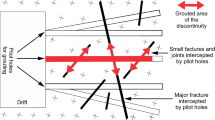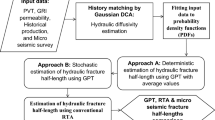Abstract
Absolute refusal is in practice impossible to achieve and is substituted by the minimal flow criterion. Grouting is stopped when the flow rate is less than a predefined quantity known as the flow rate limit. The majority of the grouting models and procedures do not mention how to calculate the flow rate limit if they do not specify empirical values. A parametric relation for the flow rate limit is obtained in this note. It binds the flow rate to the target, effective pressure, fracture opening, mix rheology and borehole. It is a flexible relation from which it is deduced that there is no need to use either the highest injection pressure or a constant pressure to attain the target. The monitored pressure can be used transforming the flow rate limit into a Running Limit. A practical case will illustrate the use of the running limit for a back-analysis of the log data of a grouting stage at La Yesca hydroelectric project. Subsequently, the minimal flow criterion will be inserted in three of the main grouting models RTGC, GIN and ALT, which will require special handling to preserve the specifications of each model.







Similar content being viewed by others
Abbreviations
- A :
-
Radius of the injection hole
- c :
-
Yield stress
- d :
-
Spread of the mix
- d i :
-
Spread in the i-th fracture
- d g :
-
Spread in the largest fracture
- d t :
-
Spread in the thinnest fracture
- D :
-
Target
- F :
-
Function
- H :
-
Half-thickness of a fracture
- H i :
-
Half-thickness of the i-th fracture
- H g :
-
Half-thickness of the largest fracture
- H t :
-
Half-thickness of the thinnest injectable fracture
- i :
-
Index number
- k :
-
Darcy’s conductivity of the mix
- L :
-
Length of the injection segment
- L g :
-
Lugeon conductivity of the mix
- L w :
-
Lugeon conductivity of water
- L wg :
-
Apparent Lugeon of water deduced from the Lugeon conductivity of the mix
- Lu:
-
Lugeon unit
- N :
-
Number of injectable fractures
- P :
-
Effective injection pressure
- Q :
-
Injection flow rate
- Q L :
-
Flow rate limit
- Q T :
-
Total flow rate
- \(\bar{Q}\) :
-
Non-dimensional flow rate
- R :
-
Reach, maximal spread at a predefined PV
- S :
-
Span, maximal spread at a predefined P
- t :
-
Time
- V :
-
Volume, marsh efflux time
- V g :
-
Marsh efflux time of the mix
- V w :
-
Marsh efflux time of water
- V 0 :
-
Brink marsh time
- γ :
-
Specific weight of the mix
- γ w :
-
Specific weight of water
- μ :
-
Dynamic viscosity of the mix
- μ w :
-
Dynamic viscosity of water
- η g :
-
Kinematic viscosity of the mix
- η w :
-
Kinematic viscosity of water
- π :
-
Pi number
- AGS:
-
Association of Geotechnical and Geo-environmental Specialists
- ALT:
-
Apparent Lugeon Theory
- EN:
-
European Standards, European Normatives
- GIN:
-
Grouting Intensity Number
- HK:
-
Hong Kong
- ISRM:
-
International Society of Rock Mechanics
- MFC:
-
Minimal Flow Criterion
- PEG:
-
Pre-Excavation Grouting
- RTGC:
-
Real Time Grouting Control
- UFC:
-
Unified Facilities Criteria
- USACE:
-
US Army Corps of Engineer
- USDOD:
-
US Department of Defense
References
Alemán-Velásquez JD, Pantoja-Sánchez A, Villegas-Lesso (2011) Geotechnical studies and design of La Yesca Dam. In: 14th Pan-American conference on soil mechanics and geotechnical engineering, Toronto. p 11
Bruce D (2013) Refusal and closure in rock grouting: let’s get it right! Geotech News 31(2):24–25
El Tani M (2012) Grouting rock fractures with cement grout. Rock Mech Rock Eng 45:547–561
El Tani M, Stille H (2017) Grout spread and injection period of silica solution and cement mix in rock fractures. Rock Mech Rock Eng 50:2365–2380
Fransson A, Stille H, El Tani M (2018) An integrated approach to rock grouting. In: 10th Asian rock mechanics symposium, Singapore. p 6
Gustafson G, Stille H (2005) Stop criteria for cement grouting. Felsbau 25(3):62–68
Gustafson G, Claesson J (2005) Steering parameters for rock grouting. Unpublished paper submitted to the International Journal of Rock Mechanics and Mining Sciences (IJRMMS), p 19. Received from Stille H (2009) in a private correspondence
Hakansson U, Wiklund J, Kotze M (2017) In-line determination of cement-based grout properties using a pulsed ultrasound based method and system. In: Proceeding of Grouting Conference, Hawai. p 12
Lombardi G (2008) Misunderstanding of GIN confirmed. Geotech News 26(2):57–63
Lombardi G, Deere DU (1993) Grouting design and control using the GIN principle. Int Water Power Dam Constr 45(6):15–22
López-Molina JA, Valencia-Quintanar JA, Espinosa-Guillén JA (2011) Grouting treatment design in foundation and abutments of La Yesca Hydroelectric Project. In: Proceedings of 14th Pan-American conference on soil mechanics and geotechnical engineering, Toronto. p 8
López-Molina JA, Valencia-Quintanar JA, Espinosa-Guillén JA, Mendietta-Torres G, Hernandez-Juárez PG (2012) Design, construction and monitoring of grout curtains for concrete face rockfill dams in volcanic rocks. In: International proceedings of symposium dams for changing world. p 7–12
Marengo H, Rivera R, Hernández E, Mena E (2015) Behavior of hydropower plant “La Yesca” Mexico, after 2 year of built. In: Proceedings of XXX National seminar on large dams, Rio de Janeiro. p 20
Mitchell JK (1981) Soil Improvement-State of the art report. ISSMGE, London
Rahman M, Hakanson U, Wiklund J (2015) In-line rheological measurements of cement grouts: effects of water/cement ratio and hydration. TUST 45:34–43
Naudts AA (1995) Grouting to improve foundation soil. Practical foundation engineering handbook. Mc Grraw Hill, New York, pp 5.277–5.400
Pitt MJ (2000) The Marsh funnel and drilling fluid viscosity: a new equation for filed use. Soc Pet Eng 15(1):3–6
Rombough V, Bonin D, Shuttle D (2006) Penetrability control of the GIN mixes during fractured rock grouting. In: Proceedings of 59th Canadian geotechnical conference. Vancouver. p 528–535
Valencia-Quintanar A, López-Molina JA, Castellanos Pedroza VY, Alemán-Velásquez J (2019) Leakage remediation of the right abutment of a concrete face rockfill dam and behavior after 5 years. In: Proceedings 14th international congress rock Mechanics and Rock Engineering. Foz do Iguassu, Brazil
Warner J (2004) Practical handbook of grouting: soil, rock and structures. Wiley, New York
Weaver K (2000) A Critical Look at Use of “Rules of Thumb” for Selection of Grout Injection Pressures. Geotech Special Publ 292(104):173–180
Zhao Z (2017) Rock grouting research in NTU, PPT presentation at the meeting of the ISRM Commission on Grouting, Cape Town, October, 2017
Standard and guideline
AEF HK (2012) TCG05 guidance notes for pre-excavation grouting. Tunnel Construction Guidelines. p 5
EN12715 (2000). Execution of special geotechnical work—grouting—grouting. (A revised updated version is expected soon)
TB 10003, J449 (2005) Code for design of Railway Tunnel (in Chinese). Professional Standard, China Railway. p 276
USACE (2017) Engineering and Design. Grouting technology. US Army Corps of Engineer CECW-EG No. 1110-2-3506. p 538
USDOD (2004) Unified facilities criteria. Grouting Methods and Equipment. US Department of Defense UFC No 3-220-06. p 91
Acknowledgements
Zhyie Zhao is acknowledged for revealing and translating the refusal criterion of the code design of railway tunnels in China, and Hakan Stille for reviewing the RTGC section of this manuscript.
Author information
Authors and Affiliations
Corresponding author
Ethics declarations
Conflict of interest
The authors are members of the ISRM Commission on grouting. They declare no conflict of interest.
Additional information
Publisher's Note
Springer Nature remains neutral with regard to jurisdictional claims in published maps and institutional affiliations.
Rights and permissions
About this article
Cite this article
El Tani, M., Lopez-Molina, J. Running Limit and Refusal in Rock Fractures Grouting. Rock Mech Rock Eng 53, 2201–2214 (2020). https://doi.org/10.1007/s00603-019-02024-y
Received:
Accepted:
Published:
Issue Date:
DOI: https://doi.org/10.1007/s00603-019-02024-y




